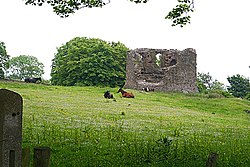Carra Castle: Difference between revisions
Created page with "{{infobox castle |name=Castle Carra |county=Antrim |picture=Castle Carra - geograph.org.uk - 467784.jpg |picture caption=Castle Carra |os grid ref=D24953344 |latitude=55.13263..." |
No edit summary |
||
| Line 1: | Line 1: | ||
{{hatnote|Not to be confused with [[Castle Carra]] in Co. Mayo}} | |||
{{infobox castle | {{infobox castle | ||
|name=Castle Carra | |name=Castle Carra | ||
Latest revision as of 19:39, 3 July 2019
| Castle Carra | |
|
County Antrim | |
|---|---|
 Castle Carra | |
| Type: | Castle |
| Location | |
| Grid reference: | D24953344 |
| Location: | 55°7’58"N, 6°2’29"W |
| Village: | Cushendun |
| History | |
| Information | |
| Condition: | Ruined |
Carra Castle or Castle Carra is a ruined castle, just north of Cushendun on the coast of County Antrim. It dates to around the early 14th century.[1]
The castle ruins stand in a field near the coast and the harbour of Cushendun, known as Murlough Bay.[2] The site had once been used during mediæval times as a children's cemetery.[1]
Name
Carra may be a corruption of "Carey".[2] It may have been known as Goban Saer's Castle.[3]
History
The castle was once occupied by Shane O'Neill, whose adoption of the semi-royal title "The O'Neill" put him in defiance of Queen Elizabeth I. In his time Sorley Boy McDonnell was held as a prisoner at Carra in 1565.[1] In 1567, two years after being defeated by O'Neill, the McDonnells entertained him in Castle Carra during two days of hunting and feasting. However, on the third day, 2 June, during a quarrel, they stabbed O'Neill to death to avenge their earlier defeat and sent his head to the English representatives of Queen Elizabeth in Dublin Castle.[1]
In 1585, Donnell Gorm MacDonnell was besieged by the English; his father, Sorley Boy landed near the castle and drove off the besiegers.[4] Around 1730, it was known to have been occupied by the Lynch family.[5] Today the castle is in ruins and overgrown with ivy.[6]
Architecture and fittings
The house has the characteristics of a hall house, but its outside dimensions are that of a tower house.[7] What remains are the ruins of a 16th-century square tower house built over a Mesolithic flint working site.
References
- ↑ 1.0 1.1 1.2 1.3 "Castle Carra". Castles.nl. http://www.castles.nl/castle-carra. Retrieved 29 May 2011.
- ↑ 2.0 2.1 Wright, George Newenham (1823). A guide to the Giant's Causeway and the north-east coast of ... Antrim. p. 58. https://books.google.com/books?id=4X0HAAAAQAAJ&pg=PA58. Retrieved 29 May 2011.
- ↑ The Gentleman's magazine. F. Jefferies. 1853. p. 503. https://books.google.com/books?id=T8DC-F2J5eYC&pg=PA503. Retrieved 29 May 2011.
- ↑ "Castle Carra". The Glens of Antrim Historical Society. http://www.antrimhistory.net/content.php?cid=118. Retrieved 29 May 2011.
- ↑ Burke, John Bernard (1852). A genealogical and heraldic dictionary of the peerage and baronetage of the British Empire. Colburn. p. 99. https://books.google.com/books?id=mDA_AAAAcAAJ&pg=PA99. Retrieved 29 May 2011.
- ↑ Gallagher, Lyn; Rogers, Dick (1992). Castle, coast, and cottage: the National Trust in Northern Ireland. Blackstaff Press. p. 43. ISBN 978-0-85640-497-9. https://books.google.com/books?id=1KBnAAAAMAAJ. Retrieved 29 May 2011.
- ↑ McNeill, T. E. (1997). Castles in Ireland: feudal power in a Gaelic world. Psychology Press. pp. 204–. ISBN 978-0-415-16537-2. https://books.google.com/books?id=LnGzv0pN4pYC&pg=PA204. Retrieved 30 May 2011.